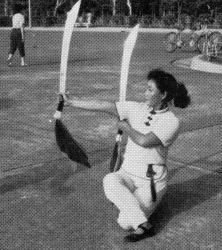
Miss Lin with double swords. |
Page 13 Fall 1992
|
I
ask about fan manipulation classes. Master Chang simply hands me an
unopened fan, shows me how to hold it at rest in my left hand, and
instructs me to follow his movements. For 20 minutes we go over and
over the first dozen or so moves, none of which involve the fan.
"Point your right hand, arm level, palm downward. Stand like
this. Bring your right arm across your face. Palm is now up. Feet
change position. Head to the other side. Arm across again, slowly like
pulling a rope. Palm down. Feet change again. Arm level. Hand position
changes, thumb down, palm out, arm curved. etc."
I
must have passed the audition, probably because I didn't insist on
learning about the fan, per se, but
took well to the discipline and the coaching. Master Chang surprised
me by asking me to come to his house over the weekend.
Fellow
juggler Ken Chen and I arranged to spend a day at the feet of the
Master. He demonstrated the forms one by one, accompanied by a
historical commentary.
Master
Chang's grandfather was the Kung Fu Master to the Ching court. He
trained Chang from age 6 in flexibility, strength and discipline, as
well as in the precise steps and moves. Now at the age of 73, Chang's
graceful, precise movements, and .his easy full split, give testimony
to a life spent in respectful memory of his grandfather's spirit and
instruction. His mentor, it should be noted, practiced his art until
his death at age 98.
Master
Chang studied the Peking Opera for 4 years, then Kung Fu and object
manipulation for 3 years, and dance for 3 years. He combined these to
create the forms he teaches. Master Chang agrees with the spirit of a
quotation from Francis Brunn, "When you want to become a great
juggler, don't look at other jugglers," but adds his own twist.
"First you must learn your Master's form completely and
perfectly. Take the time to learn it right. Only then can you innovate
and go beyond his level of skill to create something new. To most
practitioners, Kung Fu means 'force.' To me it means "time."
"The
fan provides a good example," says Master Chang. "I have
taught the basic form to over 1,000 students, but only a very few
continue to practice, remain loyal to me, and truly understand this
gentle art form. It is easy to start, but quite difficult to perfect.
The young people in Taiwan are too busy with school or with getting a
good job.
"Also
the role of the acrobat or Kung Fu master is marginal in present day
Taiwan. Status is low, and there is little money in it. Overseas
Chinese in North America and other Americans are more interested in
these arts than are young Taiwanese," he said.
Another
problem is the mistaken notion that these skills are for fighting.
They are a way of life which is intended to cultivate the mind,
discipline the body, purify the heart, diminish passion, and cultivate
peace and friendship among practitioners. All of these forms are
defensive, not offensive. I have been disappointed more than once to
find my students misrepresenting or misusing the skills I have taught
them. Students must learn the discipline, the form, and to respect
their teacher."
As
illustration of the more "martial" of his arts, Master Chang
demonstrated his skill with a heavy wooden-handled trident, about 5
feet in length, which rolled around his body, over his shoulders and
back, and around his neck, arms, and legs. He also showed his skill
with single and double cutlasses, and with twin double-headed spears.
However,
to me these weapons held less fascination than the intricacies of the
fan and the tasseled sword. This latter instrument is a heavy meal
broadsword, with a 3-foot long ornate cord and an elaborate fringed
tassel extending from the handle. It is apparent that combining the
hard form of the sword with the soft form of the cord and tassel takes
great skill and much practice.
We
were joined in our discussion by Miss Li-Hwei Lin, Master Chang's best
and most devoted pupil. Youthful at 50, she is a loyal practitioner.
Together they have appeared on many programs and have won prizes in
martial arts tournaments throughout Taiwan.
I
asked Master Chang about his future plans. After having resisted for
years, and having
turned down numerous invitations and offers, he has finally decided to
visit the United States, to give special instruction to American
students. I took the opportunity to show him back issues of JUGGLER'S
WORLD, and he indicated a willingness to come to a convention in
the near future, possibly to Las Vegas in 1984 if we can help him make
the trip.
Should
we issue an invitation to Master Chang, Miss Lin and his daughter? If
I were to arrange for a month of instruction here in the Seattle area
prior to the convention, how many people would be willing to pay a fee
equal to a proportionate share of the team's costs, which should be
about $5,000 for the period from early June through the convention.
That's $250 apiece for each of 20 students. Count me in! Any other
takers? If so, please write:
Dave Finnigan - Edmonds, WA |

Miss Lin with double swords. |